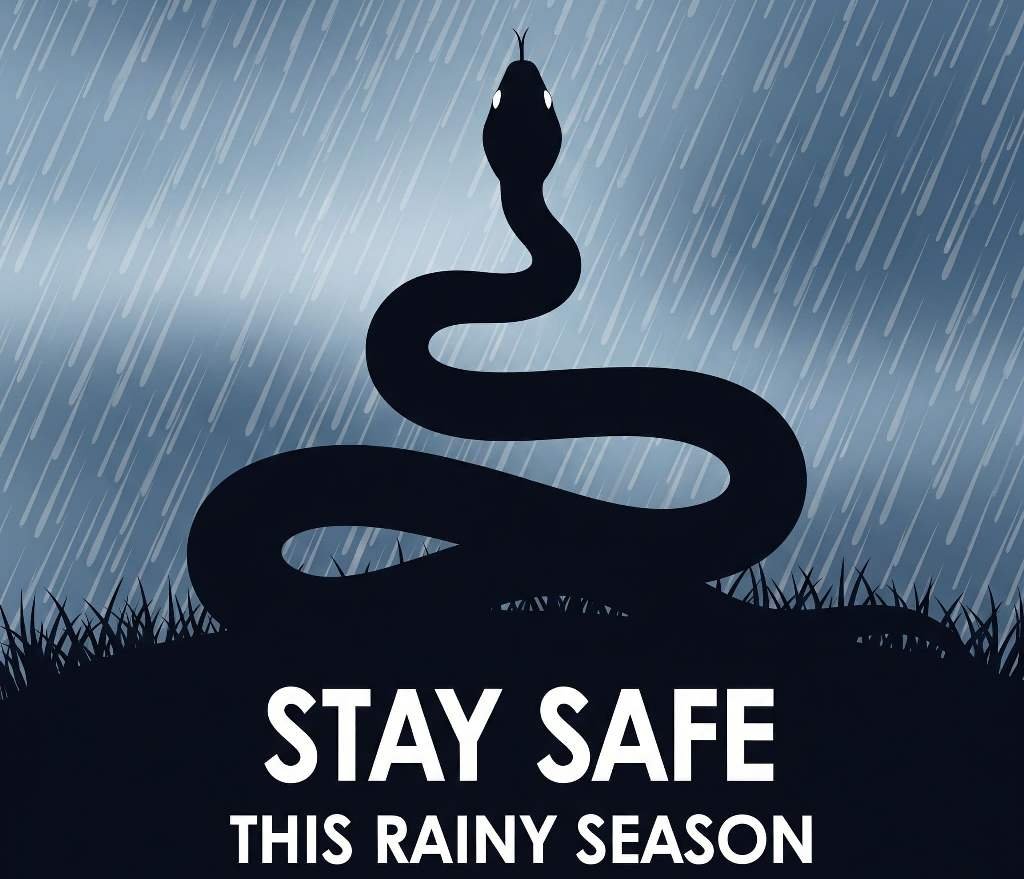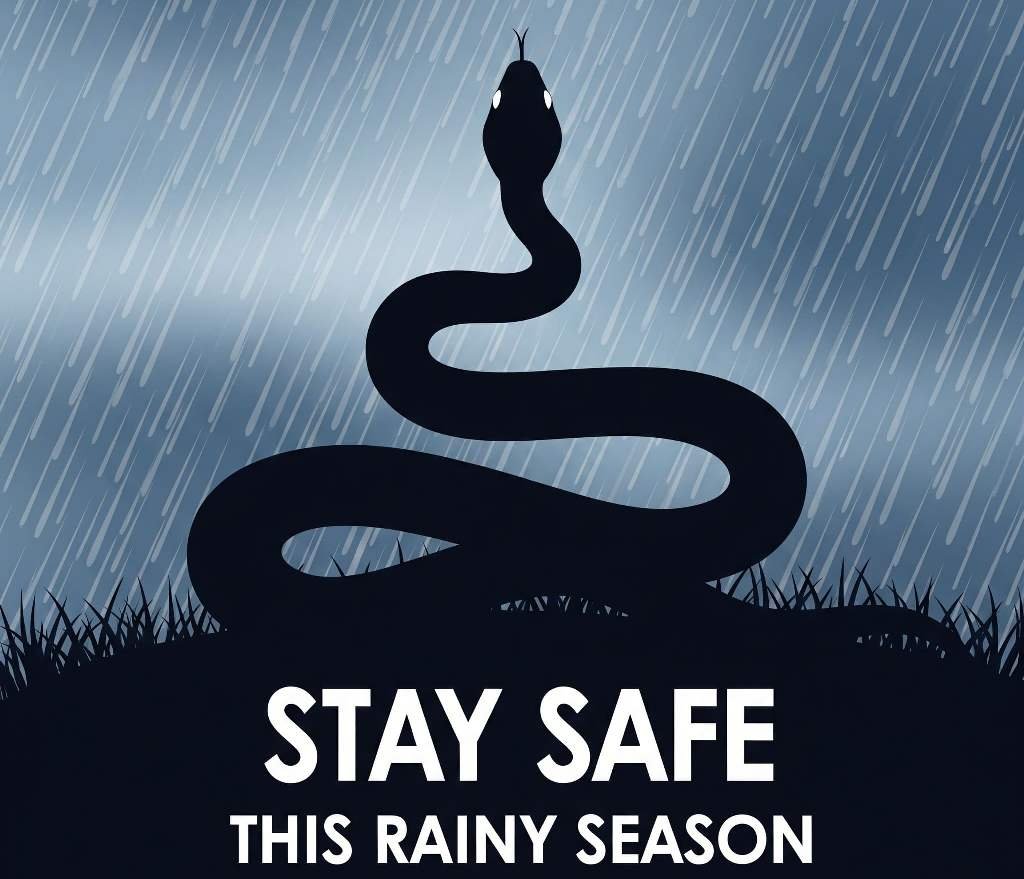Why is Monsoon a Snake Season?
Monsoon Snake Awareness: Monsoon is a beautiful season in India, with rains bringing freshness and greenery everywhere. But it also increases the chances of snake encounters. During this season, flooded burrows, increased humidity, and search for dry shelter force snakes to move closer to human homes, farms, and streets.
Snakes don’t bite unless provoked, but accidents happen when people are unaware or careless. This article will help you understand:
✅ How to avoid snake encounters
✅ What safety steps to follow
✅ Which snakes are most dangerous
✅ Why snakebite deaths happen
✅ How to protect your home and loved ones

Major Reasons for Snake Encounters in Monsoon
| Reason | Explanation |
|---|---|
| 🌊 Flooded Burrows | Rainwater floods underground shelters, so snakes come out. |
| 🌾 Increased Rodents | Monsoon increases rodent activity, attracting snakes. |
| 🏠 Human Shelter | Snakes enter homes, cattle sheds, or storage rooms for warmth and dryness. |
| 🚶♂️ Human Movement | People walk barefoot in waterlogged areas or fields, increasing bite chances. |
Most Dangerous Snakes Responsible for Deaths in India
In India, more than 90% of snakebite deaths are caused by the “Big Four” snakes:
1. Common Krait (Bungarus caeruleus)
- Activity: Nocturnal (bites mostly at night)
- Appearance: Shiny black with thin white bands
- Venom Type: Neurotoxic (affects nervous system)
- Why Dangerous?: Silent biter, no pain, but deadly if untreated. Often bites people while sleeping on the floor.
2. Indian Cobra (Naja naja)
- Activity: Active day and night
- Appearance: Hood with spectacle mark, color varies (black, brown, or golden)
- Venom Type: Neurotoxic
- Why Dangerous?: Easily found in human settlements. Can raise its hood and strike when threatened.
3. Russell’s Viper (Daboia russelii)
- Activity: Active during the day
- Appearance: Thick body with chain-like oval patterns
- Venom Type: Hemotoxic (damages blood and tissues)
- Why Dangerous?: Highly aggressive, quick to bite, causes severe bleeding and kidney damage.
4. Saw-scaled Viper (Echis carinatus)
- Activity: Mostly nocturnal
- Appearance: Small, sandy-colored, with zigzag patterns
- Venom Type: Hemotoxic
- Why Dangerous?: Found in dry regions, often steps are mistaken for stones.
Safety Tips to Avoid Snake Encounters
🏠 At Home
- Keep your home clean and rodent-free – Rats attract snakes.
- Close all openings – Cover drains, holes, and cracks in walls and floors.
- Use door sweeps – Snakes can slide through small gaps under doors.
- Avoid clutter – Do not keep piles of clothes, firewood, or garbage inside the house.
- Check before entering dark rooms or storerooms.
🌾 In the Fields or Outdoors
- Always wear shoes or boots, especially in tall grass or muddy water.
- Use a stick to tap the ground when walking in fields – this warns snakes to move away.
- Do not put hands into holes, cracks, or under rocks.
- Avoid walking barefoot, especially after sunset or during heavy rain.
- Carry a torch at night – most bites happen in darkness.
🛌 Sleeping Precautions
- Avoid sleeping on the floor, especially in rural areas.
- Use a mosquito net tucked under the mattress – it also protects from snakes.
- Shake bedding before use.
If You See a Snake
- Stay calm, do not panic or attack it.
- Keep a safe distance – most snakes will go away on their own.
- Call a snake rescuer or forest department.
- Do not try to catch or kill the snake. It is dangerous and illegal in many states.
What to Do If Someone is Bitten by a Snake
- Do not panic – stay calm and keep the person still.
- Do not suck the venom, cut the wound, or tie a tight band.
- Remove any tight clothing, rings, or watches near the bite area.
- Take the person to the nearest hospital immediately.
- Note the time of the bite and try to remember the snake’s appearance (but don’t waste time trying to catch it).
Why Snakebite Deaths Still Happen in India?
| Reason | Description |
|---|---|
| ❌ Delay in Treatment | People go to traditional healers or waste time. |
| ❌ Lack of Awareness | People don’t know symptoms or what to do. |
| ❌ No Anti-Venom Available | Rural health centers often don’t have anti-snake venom (ASV). |
| ❌ Sleeping on Floor | Increases chances of night-time bites, especially from kraits. |
Spread the Awareness
- Teach your children and family about snake safety.
- Share this article with your community, especially in villages and farm areas.
- Help others understand that not all snakes are dangerous, and even venomous snakes only bite when they feel threatened.
Final Words from WildlifeNest.com
Snakes are an important part of our ecosystem – they control pests and maintain balance in nature. During the monsoon, they are not out to harm anyone, but we must be careful and respectful of their presence.
Let’s stay alert, stay safe, and help others learn too.
Monsoon Snake Awareness – FAQs
Q1. Why do snakes come out more during monsoon?
A: During monsoon, snakes lose their underground homes due to flooding. They come out in search of dry and warm shelter, often entering homes, farms, and storage areas.
Q2. Are all snakes during monsoon venomous?
A: No. India has over 300 snake species, but only a few are venomous. However, it’s best to avoid all snakes and not try to identify them unless you’re a trained expert.
Q3. What should I do if I see a snake in my house?
A: Stay calm, don’t attack it. Call a local snake rescuer or forest department. Do not try to catch or kill it — it’s dangerous and illegal in many places.
Q4. What is the best way to avoid snakebites at night?
A: Avoid sleeping on the floor. Use a mosquito net. Keep surroundings clean and close all small holes or cracks where snakes can enter.
Q5. Which snake causes the most deaths in India?
A: The Common Krait is responsible for most snakebite deaths in India. It bites silently at night and people often don’t realize it until symptoms appear.
Q6. Is snakebite treatable?
A: Yes! If treated quickly at a hospital with anti-snake venom (ASV), most people survive. Never rely on traditional methods or delay treatment.
Q7. Can snakes climb walls or beds?
A: Some snakes can climb low walls or furniture, especially if there are openings or vines. Keeping surroundings clean and using mosquito nets helps prevent entry.
Q8. Do snakes chase humans?
A: No, snakes do not chase humans. They only strike in self-defense when they feel threatened or cornered.
🎯 Stay Snake Safe This Monsoon! 🌧️🐍
Snakes come out more during rains – protect your home and loved ones:
✅ Wear shoes in fields and at night
✅ Don’t sleep on the floor
✅ Keep surroundings clean and rodent-free
✅ Use nets, close drains & wall holes
✅ Never try to kill or catch a snake
Know the danger, respect the wild – most bites are preventable!
In case of a bite, rush to the hospital – it can save a life.
🔗 Learn more at www.wildlifenest.com – your trusted wildlife awareness hub!
#MonsoonSafety #SnakeAwareness #WildlifeNest #SnakebitePrevention #StaySafeIndia
Big Four snakes of India:
| 🐍 Snake Name | 🔗 Read More |
|---|---|
| Cobra (Naja naja) – Highly venomous, iconic hood, found across India | Read More |
| Russell’s Viper – Responsible for most snakebite deaths in India | Read More |
| Common Krait – Nocturnal and deadly, neurotoxic venom | Read More |
| Saw-scaled Viper – Small but aggressive, known for its warning sound | Read More |
Snakes in your home this monsoon?



